"When a maiden makes the sign of the cross, all hell colapses" [Émile Zolá, The Dream]
Saint George is the archetype of the Christian knight who, to protect others, confronts something much larger than himself and overcomes monstrosity, chaos, and evil. But he is also an image of protection.
There are many prayers to Saint George, all of them beautiful. I'm not sure if any are canonical, but my favorite is the one I read on one of my grandmother's holy cards, the one that says, "May my enemies be humbled beneath you" :
"I will walk dressed and armed with the weapons of Saint George so that my enemies, having feet, cannot reach me, having hands, they cannot catch me, having eyes, they cannot see me, and not even with their thoughts can they harm me.
Firearms will not reach my body, knives and spears will break without touching my body, ropes and chains will break without tying my body.
Jesus Christ, protect and defend me with the power of His Holy and Divine Grace.
The Virgin of Nazareth, cover me with her sacred and divine mantle, protecting me in all my pains and afflictions.
And God, with His divine mercy and great power, be my defender against the evils or persecutions of my enemies.
Glorious Saint George, in the name of God, extend your shield and your powerful weapons, defend me with your strength and with your greatness, and that beneath you, my enemies, remain humble and subject to You.
So be it with the power of God, of Jesus and of the Divine Holy Spirit.
Amen"
From Christian martyr to epic medieval knight
Saint George is the patron saint of kingdoms, countries, and cities (Ethiopia, Georgia, England, Portugal, Russia, Aragon, Catalonia, Barcelona, Beirut, Genoa, Lod, Moscow, and all the cities bearing his name); of armies, cavalry, soldiers, Templars, crusaders, and scouts. He is also the protagonist of biblical and secular myths and stories .
It is said that George is originally from Cappadocia, born around the year 280 and was part of Diocletian's army , his Praetorian Guard, along with Saint Sebastian, Saint Expeditus, Saint Adrian of Nicomedia and other saints who were soldiers in the Roman legions under this emperor, becaming Christian martyrs for refusing to offer sacrifices to pagan gods.
Although he is part of the hagiographic tradition (accounts of the saints), Saint George does not have a liturgical feast due to a lack of reliable information about his life. However, there is an optional memorial by the Church, which respects the cult dedicated to him. This cult is widespread throughout the world, filled with rituals in his honor and cand reflected in countless artifacts.
Although there is no closed and canonical corpus, there is a popular and literary writing that is the most famous medieval collection of saints' lives and miraculous stories: The Golden Legend( Legenda Sanctorum ) by James de la Voragine (1260) . A bestseller of its time, second only to the Bible, it shaped the Christian imagination of venerated figures like Saint George for centuries.
A shortened edition by Alianza Publishing House found its way into my hands. In the prologue, Alberto Manguel explains: " Legenda means, etymologically, 'that which should be read,' that is, 'good reading,' that which illuminates and teaches by example. The Golden Legend is essentially a collection of exemplary readings that narrate the key dates of the Catholic liturgy and the lives of the saints recognized by the Church in the 13th century."
There it is said that Saint George, in order to save the king's daughter, faced a dragon . A huge, stinking monster that, after devouring all the lambs in the region offered in sacrifice, began to feed on the young men chosen by lot, until the day it was the princess's turn. George arrived at the village and, praying to God, rammed the beast with his lance. Then he asked the maiden to take the tied dragon before the people and said: "Believe in God and be baptized ." When everyone was baptized, he drew his sword and killed the dragon.
The Golden Legend also mentions the long martyrdom of Saint George. Until his beheading on April 23 , his current feast day, he was subjected to a series of terrible torments—more than twenty in seven years—and never ceased to affirm his Christian faith, which made him one of the most venerated martyrs. It is said that 40,000 pagans converted to Christianity during those years, including Empress Alexandra , wife of Diocletian.
About torture: He was chained and imprisoned for long periods. He was whipped in public, ripped with iron hooks, and his wounds filled with salt and quicklime to increase the pain. He was tied to an iron wheel with blades that tore at his body as it turned. He was forced to drink a mixture of quicklime and vinegar. He was immersed in a cauldron of boiling lead. And each time, his wounds healed , increasing the faith of those who witnessed his endurance.
He is venerated by the Christian faith, the Druze, and Muslims. His pain and ability to uphold his faith despite martyrdom is perhaps what has made him so popular throughout the world since the Middle Ages. In addition, of course, to his courage in confronting evil and saving damsels in distress (a non-canonical story, of course).
The Power of his Drama: Sanit George and The Dragon
There are two tropes that emerge from the story of Saint George. One that transcends him and permeates all mythological, Christian (and other religious) and superhero narratives is the struggle of good versus evil —or chaos. It is related to the allegory known as Psychomachia(based on a popular Latin poem), about a religious battle where virtues confront vices in the battle for the soul of man.
And the particular motif of Saint George, although it is repeated in other saints' days and myths, is the archetype of the courageous knight who faces the dragon or the serpent to save the maiden , a specific motif of medieval popularity.
One of the best-known versions of this legend is the one in which Saint George rescues Princess Sabra from the dragon. She set out dressed in bridal attire to be sacrificed, resigned to her fate, and at that moment, George, a Christian knight armed with a lance, appeared. The rest is history, retold and depicted many times, especially by the English Pre-Raphaelites, for its high spirituality and its contrast with modern, industrial machinery .
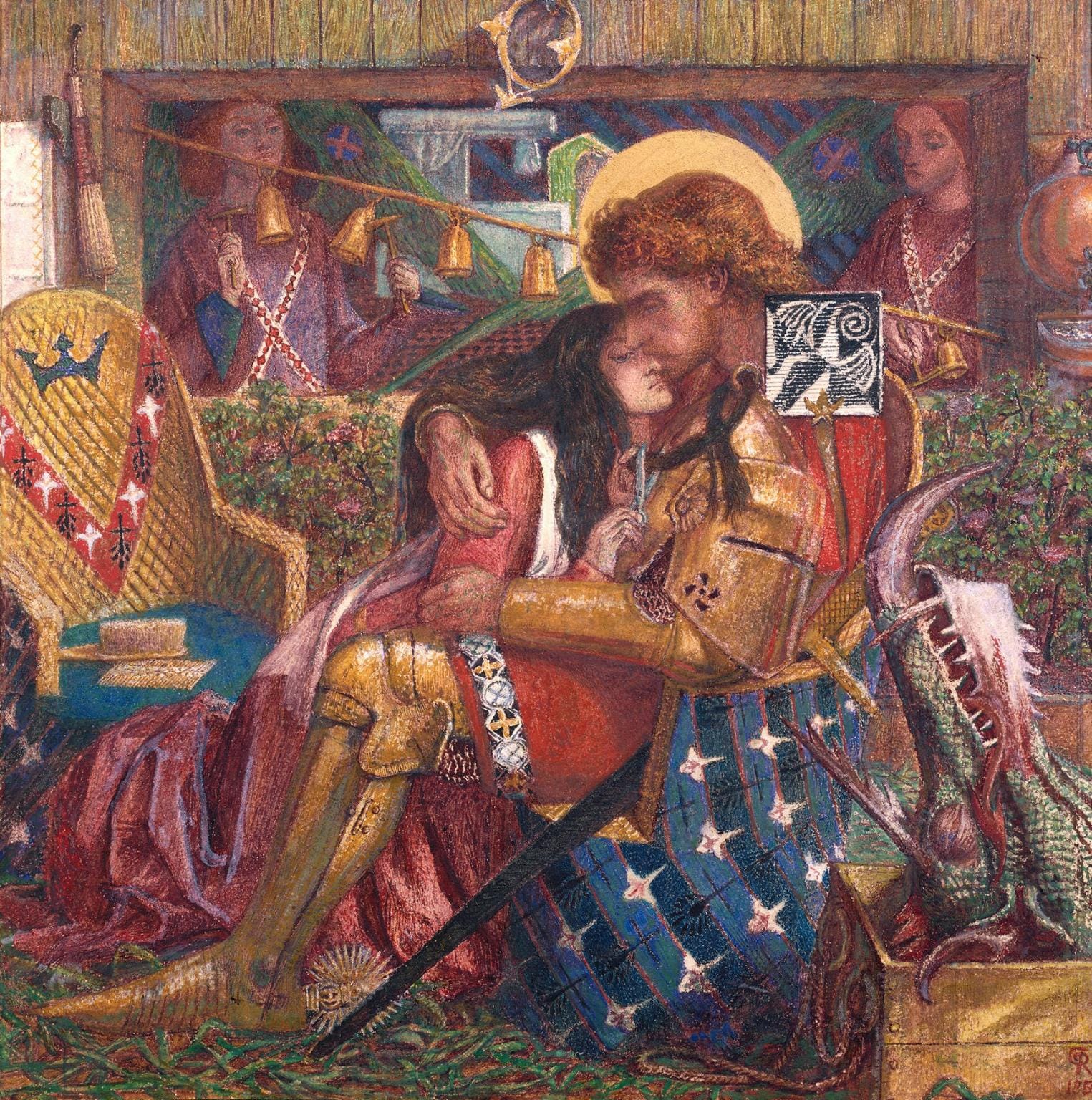
Saint George becomes the canonical archetype, although he actually recycles much older pagan elements. The hero who defeats the monster, who confronts the beast, is an allegory that predates Saint George; it is a universal structure of epics. From Perseus and Andromeda, Hercules against the Hydra, through the Norse tale of Siegfried against the dragon Fafnir, to Indra's victory over the serpent-demon Vritra, who held back the waters, in Hinduism.
The most biblical and direct version of this representation is that of Saint Michael the Archangel in the Book of Revelation (12:7-9), who defeats the dragon Satan. And Saint George, his most popular and closest version. Saint Michael is the victory of the divine over evil, an angelic model. Saint George is the human model, the knight who faithfully reproduces that same victory on earth; a political and cultural saint, not just a religious one. Where Saint Michael is dogma, Saint George is myth.
And it is a myth that, like others, is based on the human need to create them to process the chaos of life, the catastrophes, the misfortunes, the passions and even apathy.
The Relics of Saint George
From the earliest centuries, the Catholic Church upheld the worship of relics as a legitimate practice, reaffirmed at the Council of Trent (16th century), in contrast to Protestants who rejected them. Now, worship is reserved solely for God and ignores objects. Today, the Church considers the veneration of relics to be part of popular piety and a valid expression of faith , as long as it is not confused with superstition.
From Lod to Byzantium and from Byzantium to Europe, what are presented as the relics of Saint George are scattered throughout the world. According to the oldest tradition, he is buried in Roman Palestine, Lod, Israel. In the 4th century, a basilica was built over his tomb, and today the Greek Orthodox Church of Saint George houses what is considered the saint's original tomb.
The Byzantine Empire distributed relics to several other churches. The most famous is the Monastery of St. George in the Phanar , seat of the Ecumenical Patriarchate, which still houses them. Some others, such as its standard, were brought to Rome to the Church of San Giorgio in Velabro .
There are other places where he is venerated that claim to hold relics of the saint. From the Cathedral of Valencia, with an excerpt from his ulna, to the Greek Orthodox Cathedral of St. George in Hartford, USA, with a phalanx. Perhaps the fascinating thing about relics isn't their authenticity, but the human persistence in clinging to fragments to give substance to what cannot be seen.
Beyond the theological aspects, venerating an object, even without falling into fetishism, remains a popular phenomenon , compelling, and perhaps necessary for those who need a something tangible to connect with the sacred or with memory. It's a bond; it's not divine, but there's something in it that connects with the sacred, as if it channels that faith. Popular devotion, through a material symbol, is also a path to spirituality .
The Attributes of Saint George
The best-known emblem is the red cross on a white background, the Cross of Saint George , in the form of a banner or shield. Then there's his knightly armor, which is a symbol of his role as a soldier and martyr. His lance and sword, with which he pierces the dragon, represent the faith that conquers evil . The dragon is also an allegory of paganism or the devil. The white horse is a sign of purity and victory. And the palm frond, when it appears, refers to the martyrdom of the saints.
The red rose is not one of its attributes but a symbol derived from the Catalan tradition of Sant Jordi Day (April 23), the festival in which it is celebrated. According to legend, a red rosebush sprouted from the blood of the dragon Saint George slew, and he took a rose to give to the princess he had rescued. That's why roses (and books) are given as gifts in Catalonia.
Saint George in Ancient and Classical Art
Just as Ovid's Metamorphoses transformed Greco-Roman tragedy into mythological narratives about the origin of the world, the Golden Legend also became a painter's manual. These are some of my favorites.
European Art
In the Renaissance and Baroque periods, Saint George was a central theme for exploring the tension between chaos and order. Each painter, in his own way, used the myth to display technique, faith, and style.
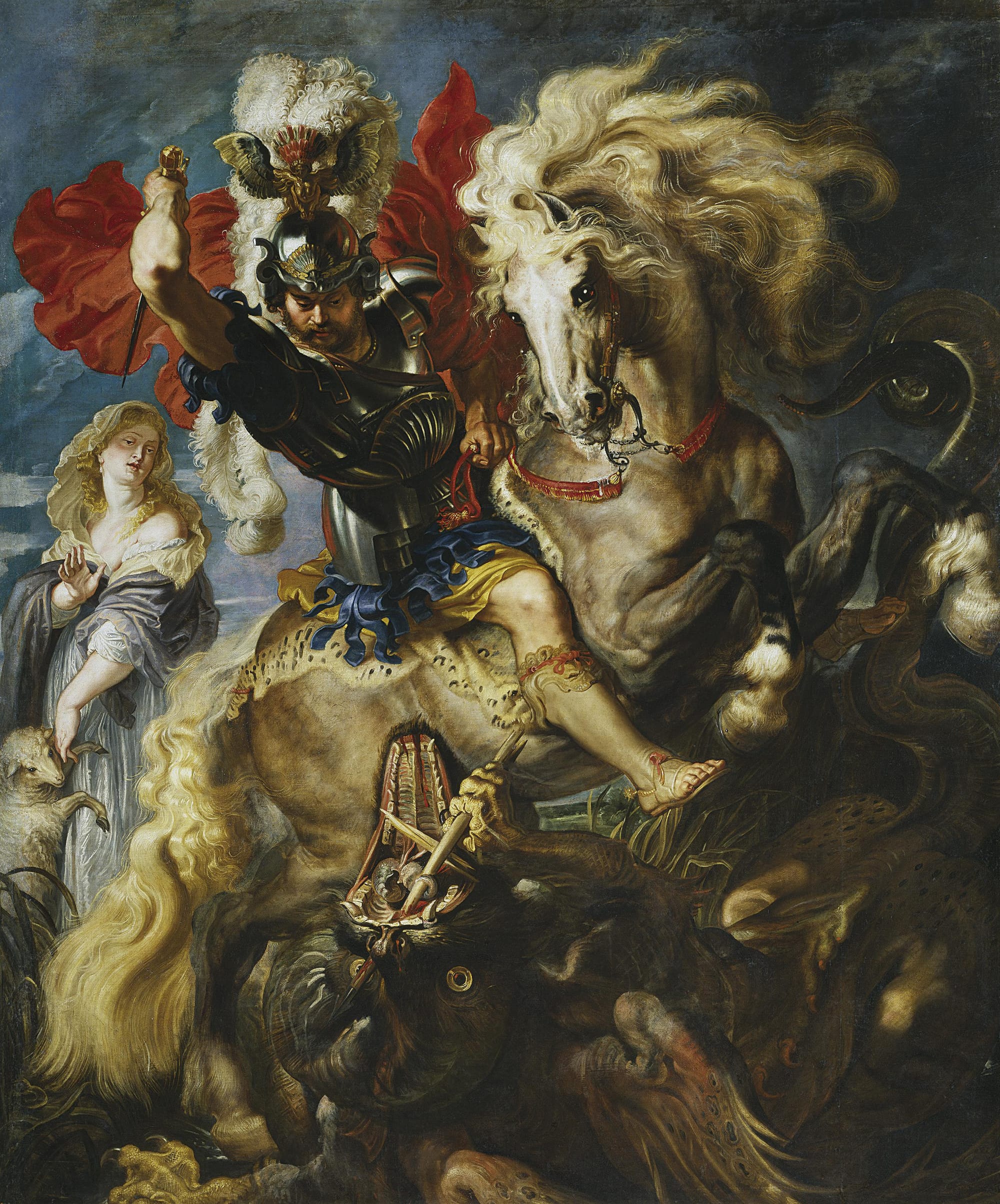
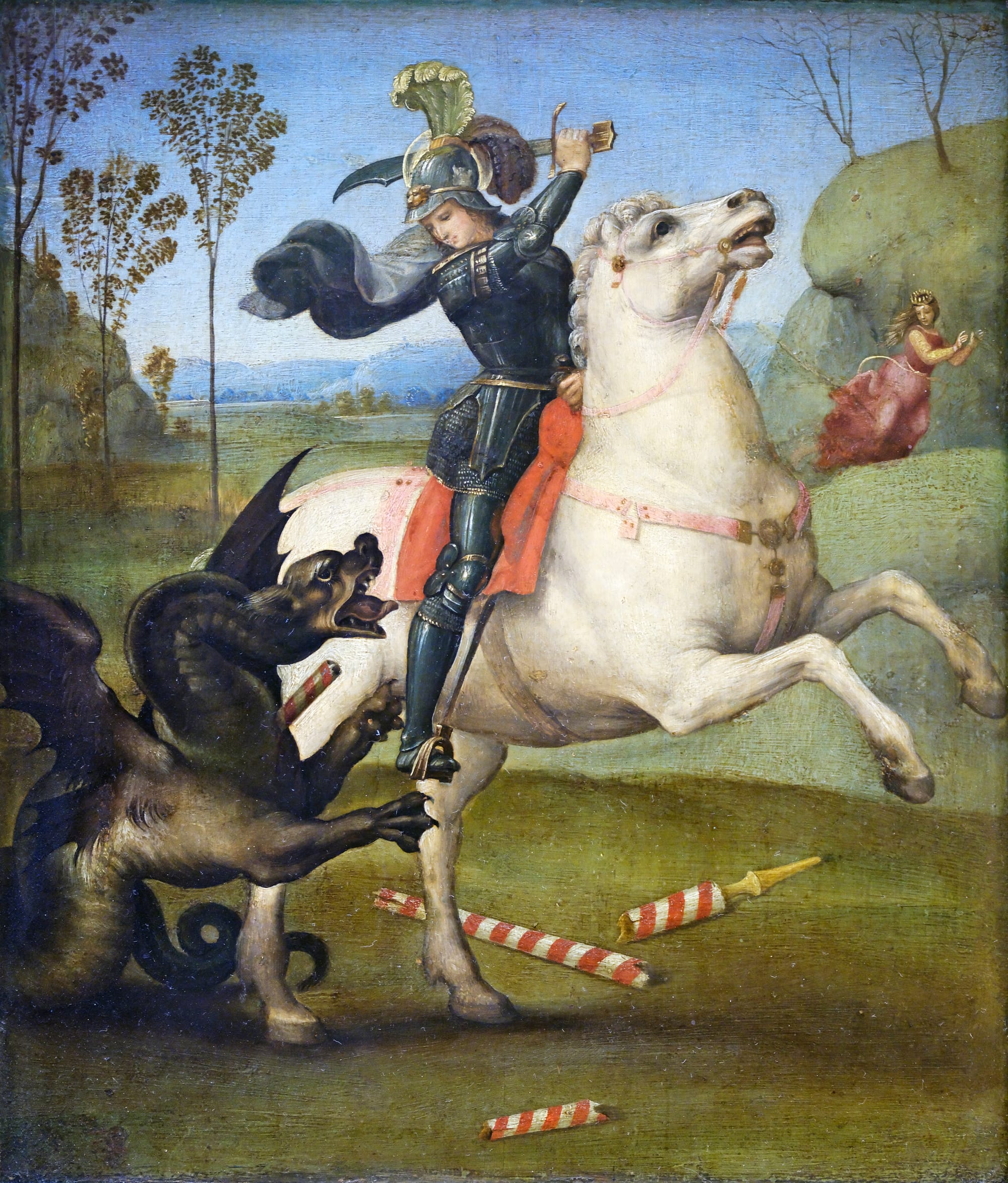
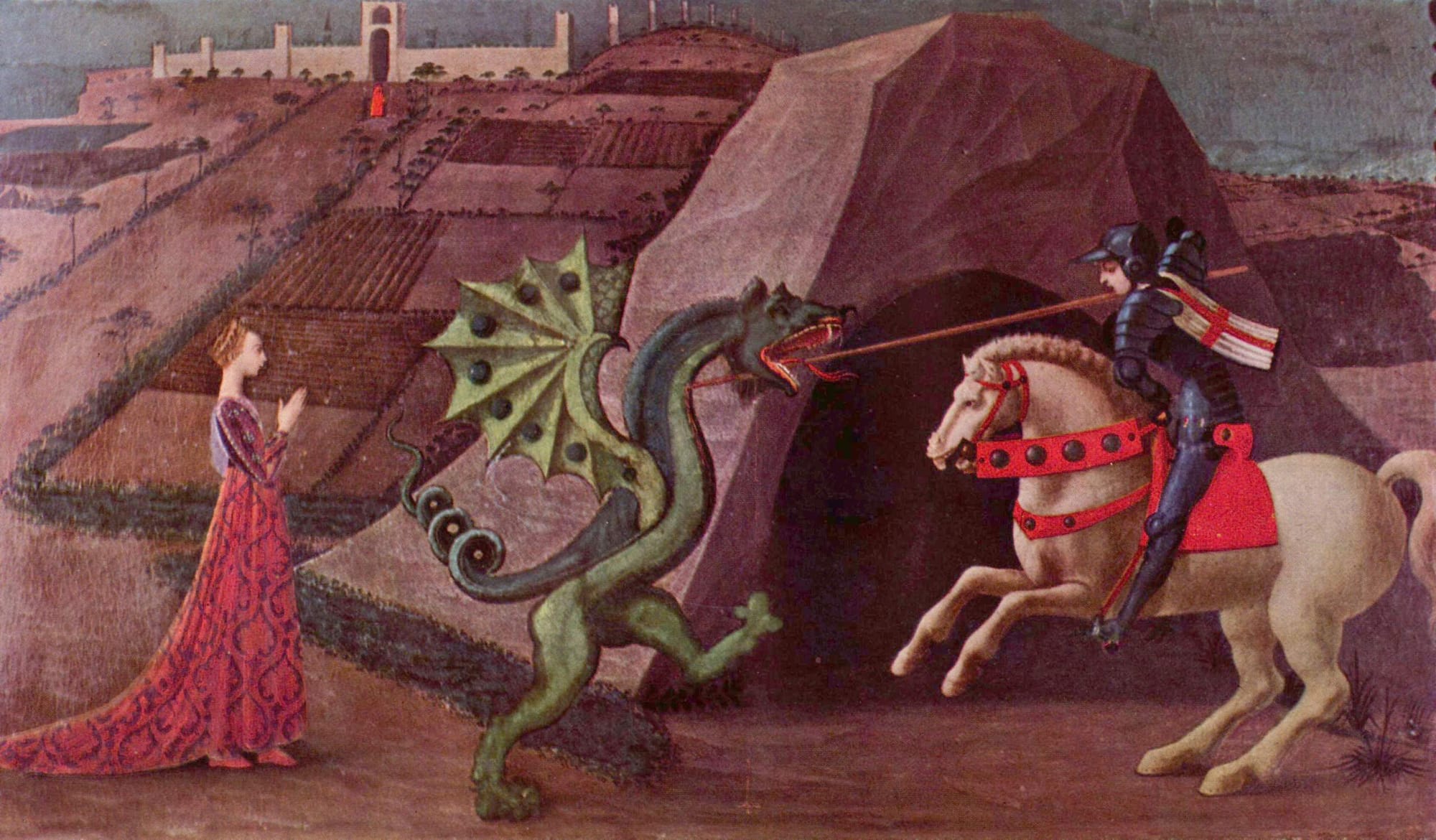
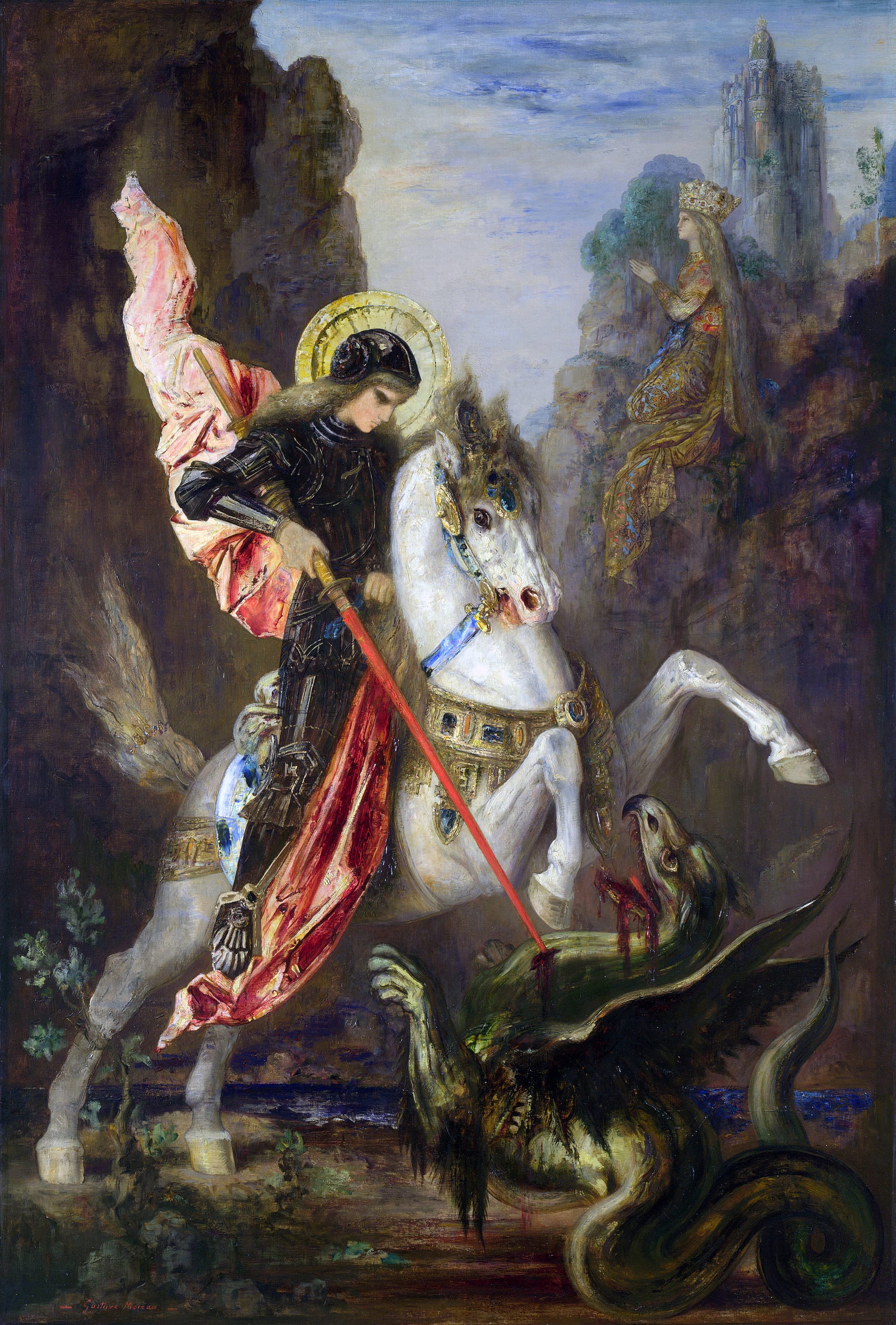
Russian Art
In Russian tradition, Saint George is not a chivalric hero but a warrior saint, protector of the community, who was early adopted as a patron saint and symbol of victory and faith. Among these two paintings from the Novgorod School, the first features a brown horse, emphasizing the human and earthly.
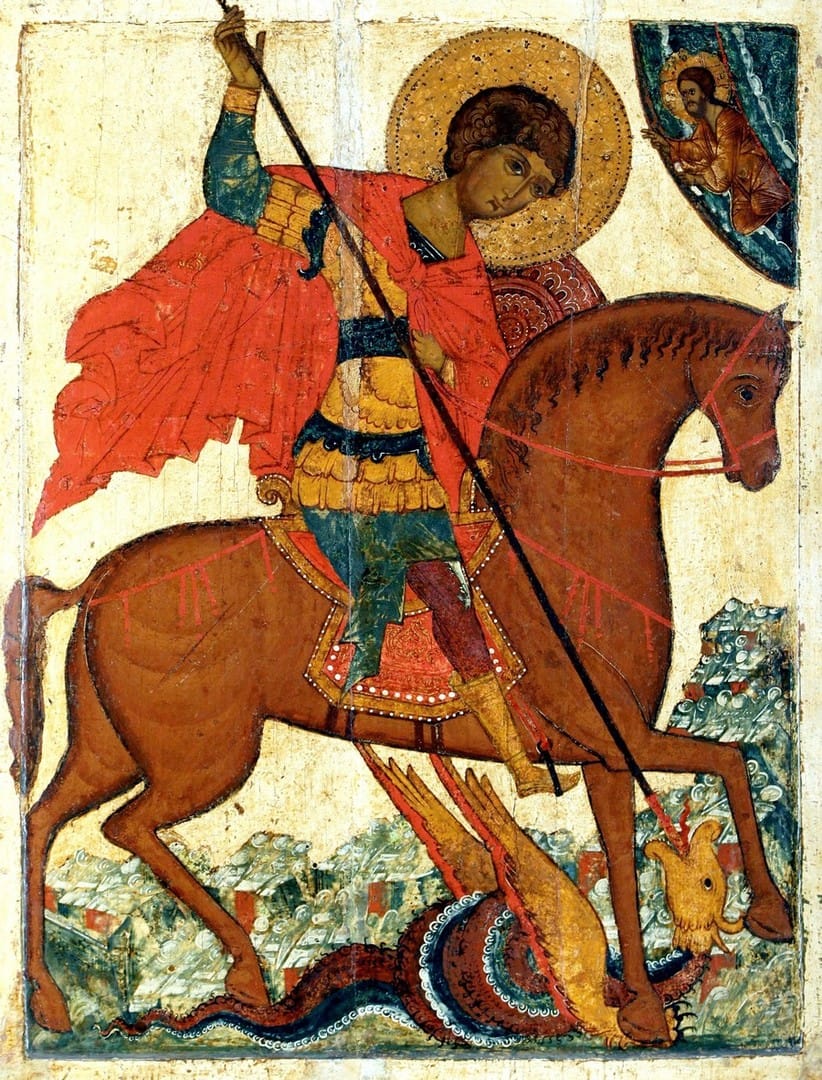
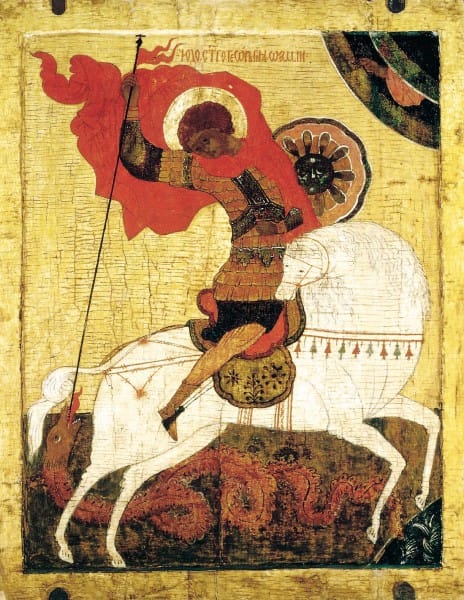
Byzantine Art
In Byzantium, Saint George appears closer to divine eternity than to the flesh of a martyr. Byzantine art canonized his image, with a sacred presence, as an archetype crystallized in stone and gold.
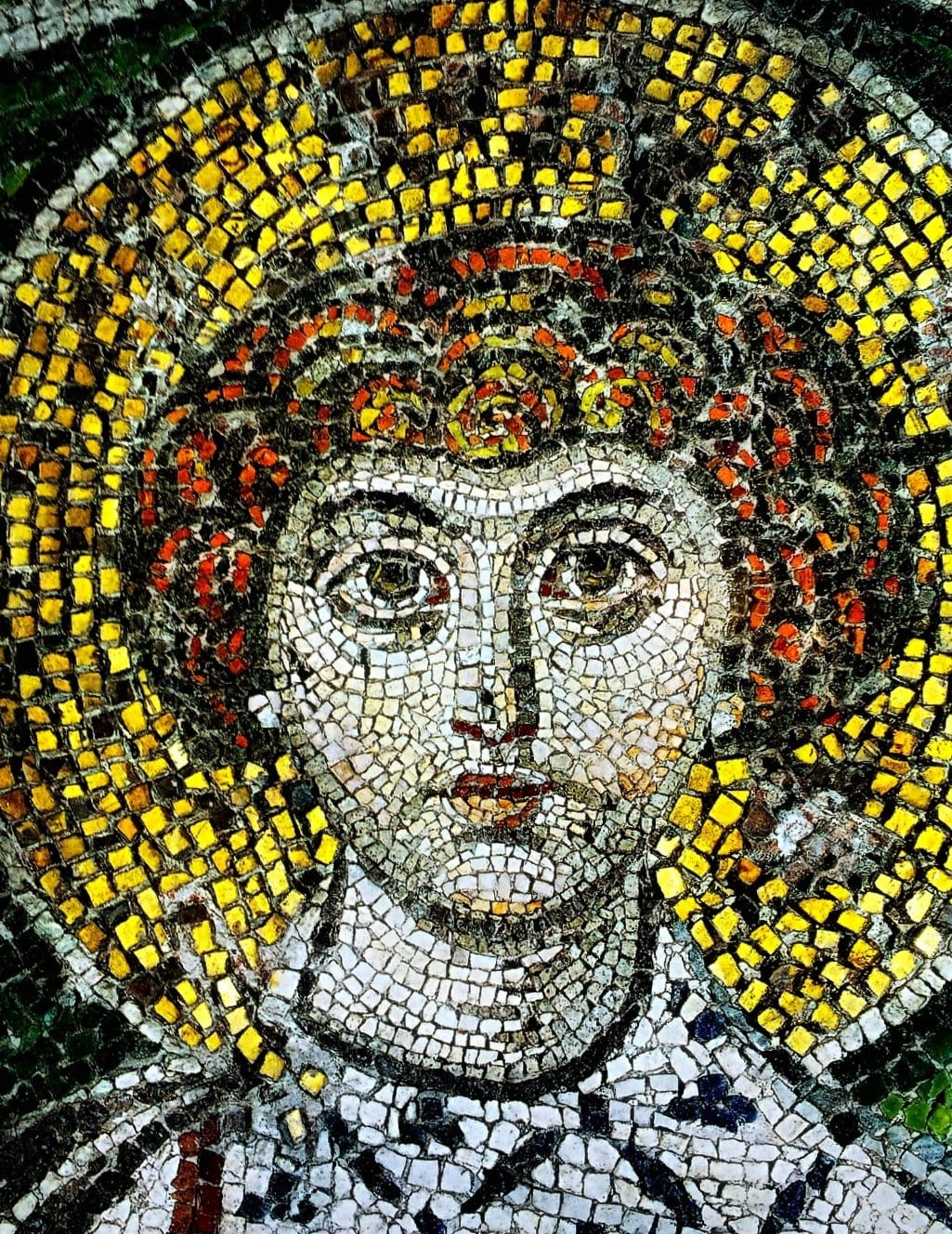
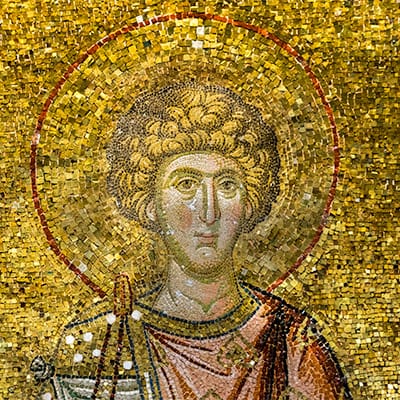
Saint George in Pop Culture
The iconography of Saint George—armor, red cross, white horse, lance, roses—became an easily recognizable and recyclable repertoire. Whether it's a Renaissance oil painting or a football shirt, the figure of the knight defeating the dragon serves as a universal synonym for victory, faith, and protection .
In Brazil, Saint George is Ogun in Afro-Brazilian syncretism: the orixá of war, iron, and struggle. In Rio de Janeiro, his festival draws crowds and combines Catholic processions with Candomblé and Umbanda rituals. The figure of the saint-knight was also an African warrior, an emblem of resistance and spiritual strength in a colonial and mestizo context. And his image appears around every corner, also in the form of tokens (or pins).
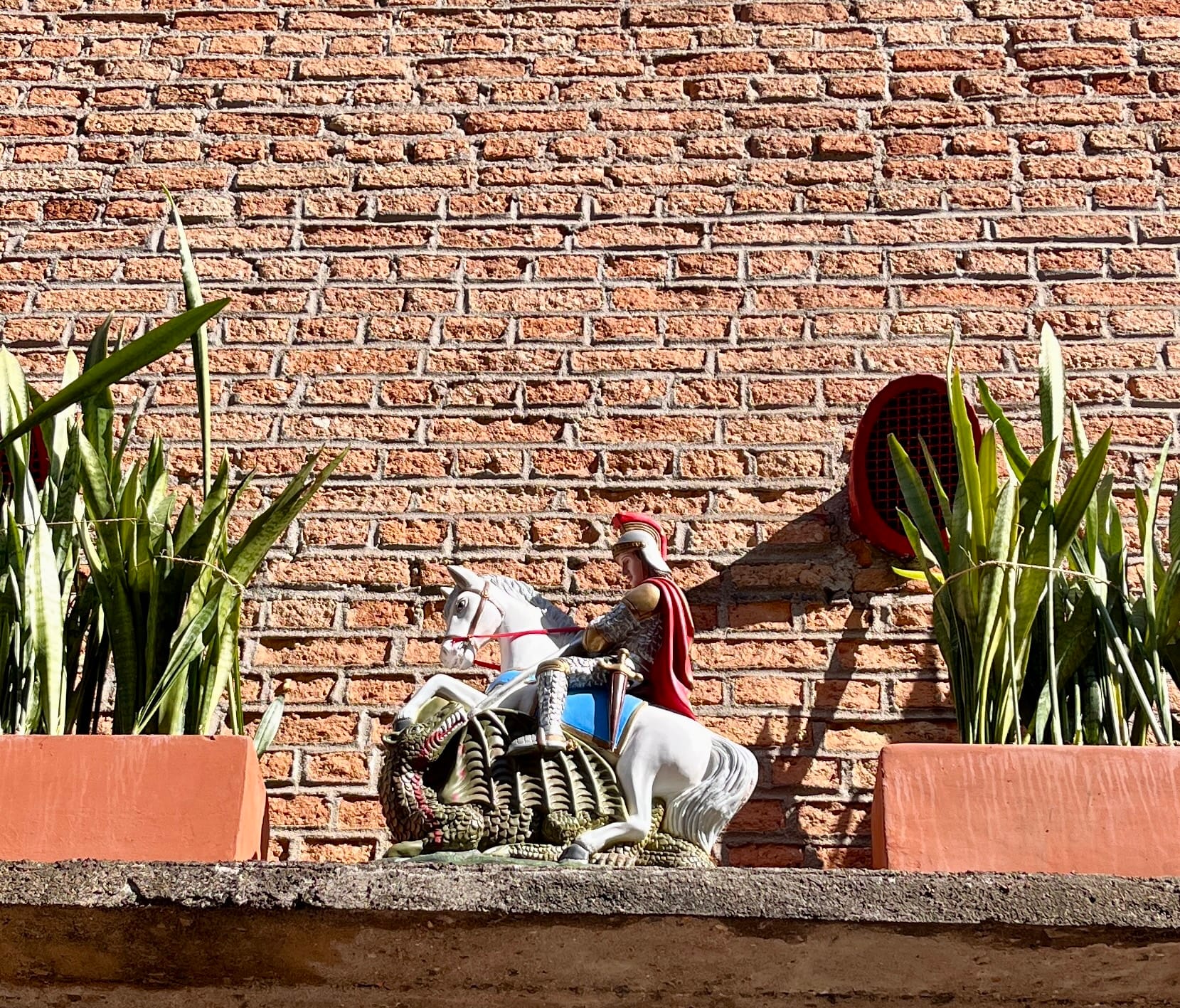
The popular passion for football is no exception to this veneration. Aldosivi, in Mar del Plata, adopted him as its patron saint as well as Rosario Central, both teams from Argentina. FC Barcelona and Genoa CFC bear the Cross of Saint George on their coats of arms because it is part of their cities' heraldry. Like a symbol of identity, a banner, it encapsulates history, faith, and belonging.
In The Eternaut , the Argentine Netflix series, Saint George appears frequently, among dreams, nightmares, visions, and catastrophes. But he also appears in the settings of the main plot. In Campo de Mayo, the protagonist Juan Salvo is drawn to the monument to this saint and another character tells him, "Don, don't avoid the Faith. The dragon is on the loose ." It seems like a symbol of divine and human protection for Salvo, who faces monsters from another planet.
In Assassin's Creed , the saga obsessed with the Middle Ages and the Crusades, Saint George appears in a Valhalla memoir called The Legend of Saint George . Pieces of the saint's armor are obtained there as loot after completing missions. In Age of Empires II, Saint George doesn't appear, but there are indirect references to him, and his iconography is present in the Georgian civilization.
We’ve Always Longed for Heroes
Saint George was canonized in 494 AD by Pope Gelasius I , who included him among those saints "whose names are justly venerated among men, although their actions are known only to God." A saint is someone who has been chosen by God to serve a divine purpose: perhaps companionship, the symbol of unyielding faith, the strength of spirit to overcome danger, sorrow, and conflict.
And beyond that early canonization, it was popular tradition that paved the way, multiplying stories with a narrative force that moves us to this day, and turning Jorge into a myth that traveled from East to West, from the liturgy to the street, and from the greatest paintings to the holy card in our wallets.
The very name Jorge preserves this duality of evidence and legacy: in Greek, it means "he who works the land." But in the Middle Ages, as the cult of Saint George spread throughout Europe, the name became mixed in popular perception with other Germanic names with warrior roots, and since then, it has carried both meanings: peasant and combatant . Jorge, I recall, was Bergoglio: Francis, the Pope born and raised in Argentina. And Jorge is also García Cuerva, our Archbishop. What more examples of sowing.
Some might think otherwise, but we need heroes: to survive evil, to feel protected, and to sustain us during crises of faith and vitality. Epic courage sometimes functions as a refuge, other times as an impulse. From superheroes or idols to saints, the search for spiritual support, for a certainty of courage and strength, is a human need.
And there are stories that live on because they condense enormous ideas and inspire even the centuries. The universal endures. Legends are updated. Symbols endure because the need to invoke them transcends time and space.
From Roman martyrdom to medieval knighthood, from relics to football shirts, Saint George is there to confront our dragons, under all the names that evil takes in each era.

